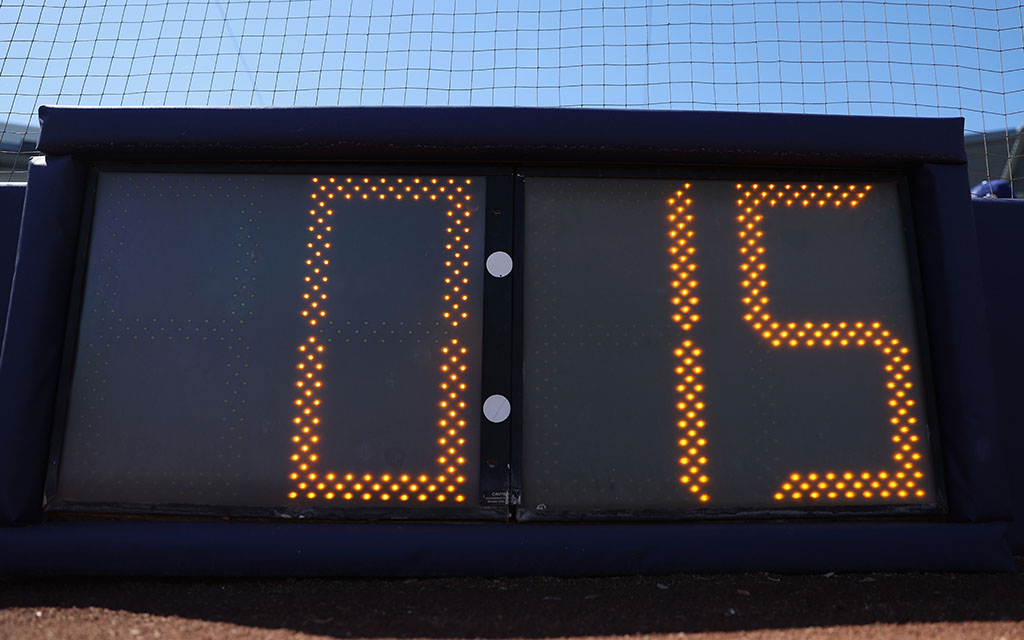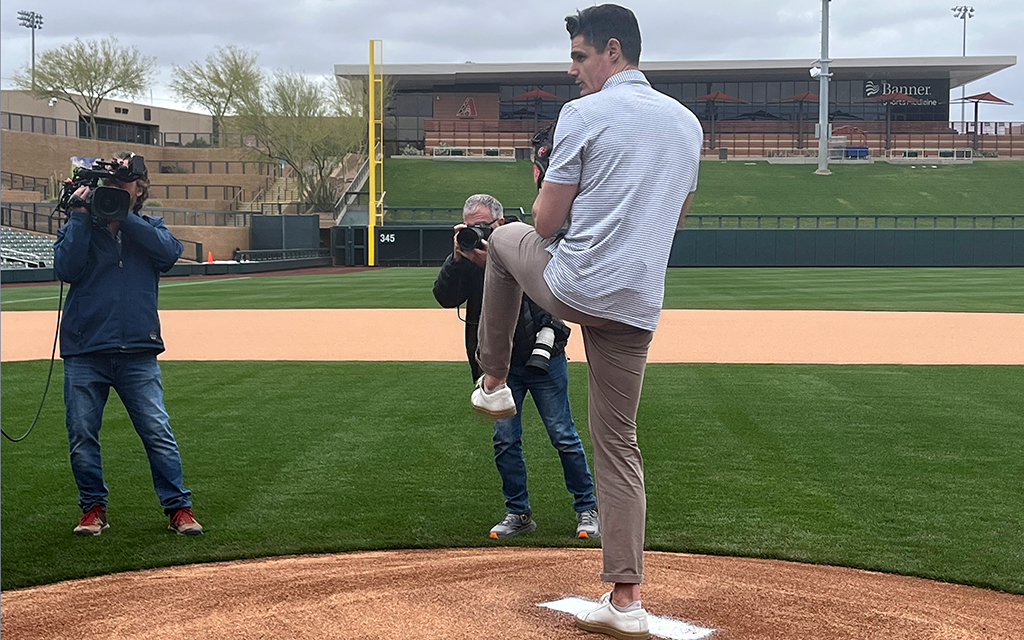
MLB will officially introduce a pitch clock on Opening Day as part of the league’s rule changes aimed at improving pace of play. (Photo by Christian Petersen/Getty Images)
SURPRISE – On Saturday, a normally insignificant Grapefruit League game quickly became a hot topic in baseball circles when the Atlanta Braves’ Cal Conley struck out on a full count with the bases loaded in the ninth inning, with MLB’s official play-by-play reading “Cal Conley strikes out on an automatic strike.”
Conley failed to be “ready and alert” in the batter’s box with eight seconds remaining on the pitch timer after the Braves battled back from a three-run deficit to tie the game. Instead of playing hero in a walk-off win, Conley became the center of a national debate regarding the newly-installed pitch clock, particularly, for its largest detractors.
The unavoidable growing pains are expected – and a new wrinkle at spring training in preparation for the regular season.
“I think it’s going to be chaos at the beginning,” Kansas City Royals manager Matt Quatraro said.
To the league, a game ending on a pitch timer violation is not a bug, it’s a feature. The call coming at such a significant part of a game serves as a cautionary tale for MLB clubs, which will have to reckon with the fact that no moment is too big to ignore the pitch clock rules. Of course, it also comes as a consequence of MLB instructing its umpires to call violations “with no grace period.”
Limits on defensive shifts and bigger bases are other new features in spring training, but the learning curve is less steep for teams and fans. Pitchers have 15 seconds between pitches with no runners on base and 20 seconds with runners. If a pitcher does not deliver a pitch in time, it results in an automatic ball. At the plate, batters need to be ready to hit in the batter’s box with eight seconds left on the pitch clock. Violating this rule results in an automatic strike called on the batter.
Timers are strategically placed around all spring training facilities, similar to the NBA’s 24-second shot clock. The scoreboard in the left-center field at Scottsdale Stadium, where the San Francisco Giants work out, displays a giant 15-second timer, which constantly runs throughout practice.
As the players get work in, they also become aware that 15 seconds go by quickly.
“Right now, we’re just drilling the new rule changes into the players,” Giants manager Gabe Kapler said. “We’re trying to hit it from every angle. We have clocks all over the place and have conversations about it.”
Despite practicing with the clock through the first two weeks of spring training, some players still need help perfecting the timing. In the first weekend of Cactus League play, San Diego Padres third baseman Manny Machado received the first violation of the spring training season after not stepping into the batter’s box in time.
Following his at-bat, Machado took part in an in-game interview with Bally Sports San Diego’s broadcast and discussed being the first culprit of the new rule.
“I might be down 0-1 a lot this year. The clock is very fast,” Machado said. “There’s definitely going to be an adjustment period, but it looks like I’m going down in the history books.”
For some players participating in spring training, the pitch timer is not a new concept. Those who have participated in Triple A and Double A at any point since 2015 saw a version of the pitch clock, albeit with slightly different timings (14 seconds with no base runners and 18 with players on).
The ultimate purpose of the pitch clock is a solution to fix one of baseball’s most criticized issues in the pace of play. MLB stated the pitch timer reduced the duration of games by 25 minutes in last year’s minor league season.
While it’s still early, MLB’s latest creation seems to be serving its purpose. Despite rotation changes, the Royals’ spring opener lasted only 2 hours, 33 minutes. All spring training games through Sunday averaged 2 hours, 38 minutes over 35 games. Last season saw an average game length of 3 hours, 6 minutes; through Sunday, only six games were over 3 hours long.
A non-roster invitee of the Royals, Brooks Kriske spent time with the pitch timer in 2021 during his time playing Triple-A ball for affiliate clubs of the Yankees and Orioles. Even with his experience pitching under a timer, Kriske still committed a “pitcher pitch timer violation” by allowing the 20-second timer to expire in his only inning of work.
“The eight seconds really is early,” Kriske said. “Pitchers can set and just hold it and the batter can’t do anything. There’s kind of a game-within-the-game in that,” Kriske said.
For Royals rotation pitcher Zack Greinke, Monday’s matchup against the Milwaukee Brewers was his first in-game experience with the clock. After pitching two shutout innings, he cautioned the potential for injury.
“I might have trouble in longer innings, if there’s 25 or 30 pitch innings, (then) a quick inning and I have to go back out,” Greinke said. “I think there might be some issues with recovery.”
The timer is far from the only change affecting the upcoming season. Pitchers are limited on their number of mount visits and pickoff attempts, with no more than two “disengagements” allowed per batter. In addition, the league also introduced new restrictions on defensive shifts in the infield in the upcoming season.
In the past, teams could load up infielders on one side of the field based on a batter’s scouting report. Now two players must be on each side of second base and stand on the infield dirt at the time of the pitch.
Not having the shift forces managers to rethink their defensive alignments.
“For all of our infielders, it’s important for them to get a jump on the ball. Without the shift, guys who are late off the ball or have no range will be exposed,” Los Angeles Dodgers manager Dave Roberts said.
With the newly implemented rules changing how some aspects of baseball are played, teams will continue to use spring training to perfect their knowledge of the rules before Opening Day.
“I keep a copy of the rules in my pocket so that someone could ask me what the rules are, and I will have them right there,” Kapler said. “We are all practicing, and we’re all doing our best.”


